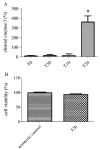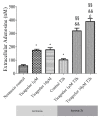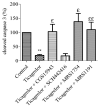Ticagrelor Prevents Endothelial Cell Apoptosis through the Adenosine Signalling Pathway in the Early Stages of Hypoxia
- PMID: 32397519
- PMCID: PMC7277469
- DOI: 10.3390/biom10050740
Ticagrelor Prevents Endothelial Cell Apoptosis through the Adenosine Signalling Pathway in the Early Stages of Hypoxia
Abstract
Background: Several studies have reported the beneficial effects of anti-platelet drugs in cardioprotection against ischaemia-reperfusion injuries. To date, no studies have focused on the indirect cytoprotective effects of ticagrelor via adenosine receptor on the endothelium.
Method: By evaluating cell viability and cleaved caspase 3 expression, we validated a model of endothelial cell apoptosis induced by hypoxia. In hypoxic endothelial cells treated with ticagrelor, we quantified the extracellular concentration of adenosine, and then we studied the involvement of adenosine pathways in the cytoprotective effect of ticagrelor.
Results: Our results showed that 10 µM ticagrelor induced an anti-apoptotic effect in our model associated with an increase of extracellular adenosine concentration. Similar experiments were conducted with cangrelor but did not demonstrate an anti-apoptotic effect. We also found that A2B and A3 adenosine receptors were involved in the anti-apoptotic effect of ticagrelor in endothelial cells exposed to 2 h of hypoxia stress.
Conclusion: we described an endothelial cytoprotective mechanism of ticagrelor against hypoxia stress, independent of blood elements. We highlighted a mechanism triggered mainly by the increased extracellular bioavailability of adenosine, which activates A2B and A3 receptors on the endothelium.
Keywords: adenosine receptors; cytoprotective effect; endothelium; extracellular adenosine; ticagrelor.
Conflict of interest statement
C.F., H.P., G.P., S.B.-P., F.O., P.N., H.M., and Z.D. declare no financial relationships with any organizations that might have an interest in the submitted work. No other relationships or activities that could appear to have influenced the submitted work.
Figures






References
-
- Fisher M. Injuries to the vascular endothelium: Vascular wall and endothelial dysfunction. Rev. Neurol. Dis. 2008;5(Suppl. S1):S4–S11. - PubMed
Publication types
MeSH terms
Substances
LinkOut - more resources
Full Text Sources
Research Materials

